With the interest and response to Elisabetta Sforza’s latest book, The ABC of Padded Stitch – which, incidentally, will be back in stock by this Wednesday – I’ve had a boatload of questions about coton a broder, the cotton embroidery thread that Elisabetta recommends for much of the satin stitching in her book.
I’ve written about coton a broder quite a bit on Needle ‘n Thread. It is one of my favorite embroidery threads for monogramming, along with cotton floche.
I use it and floche in Stitch Sampler Alphabet, which is my most popular PDF project book. The decorative initials in Stitch Sampler Alphabet really show off the qualities of both coton a broder and floche for surface embroidery (although you can use regular embroidery floss for those projects, as well).
Today, I just want to present some quick information about coton a broder, compared to stranded cotton – or what we call “embroidery floss” here in the US. Since there’s a little confusion between the two, I thought I could quickly highlight some distinctions for you.
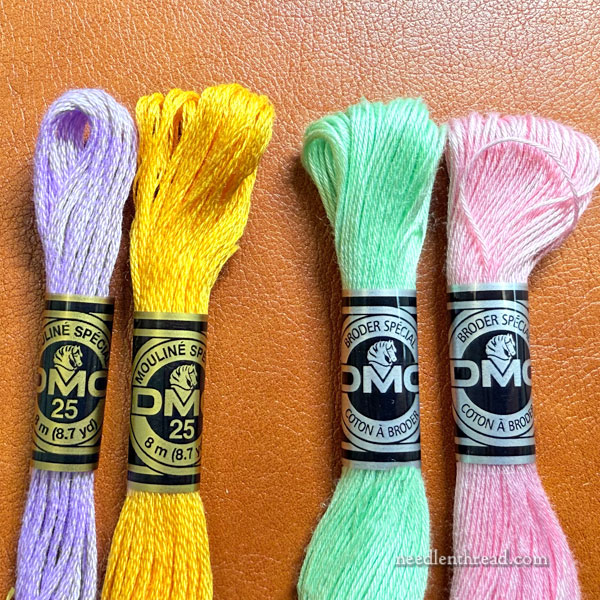
The most important point to make here is that coton a broder and embroidery floss (stranded cotton) are not the same thread. Though they are both 100% cotton, they differ entirely in their make-up and structure.
Both threads can be used for all kinds of surface embroidery. Both threads can be successfully used for satin stitching and monogramming. But the outcome will look different, because they aren’t the same thread.
If coton a broder is new to you, you might find that the labels on the threads can cause confusion. This point has come up in my email a couple times lately, for folks shopping for coton a broder.
The most common size of coton a broder is #25, and that’s what we’re going to concentrate on today since it’s the thread size you’re most likely to use if you’re working from Elisabetta’s book.
In the photo above, the two threads on the right are coton a broder #25.
The two threads on the left are stranded cotton (6-stranded cotton floss, that’s surely the most common and familiar embroidery thread these days).
You’ll notice that the label on the cotton floss on the left has the number 25 on it. And this is the point of confusion. I’ve had several folks reaching out asking if it is the “coton a broder 25” that Elisabetta is using.
It is not.
Let’s look at the labels up close:
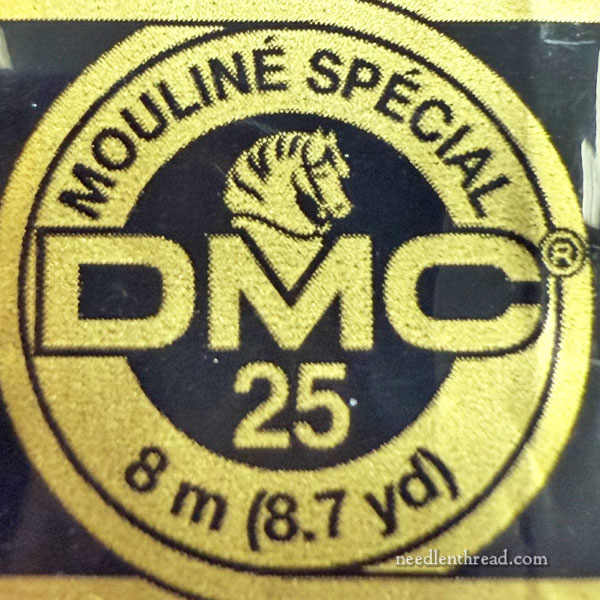
This is the label for your typical DMC stranded cotton (floss).
Notice that it is gold and black. It is called “mouliné spécial” in the fine print around the DMC 25. “Mouliné” translates to “stranded.” And the 25 indicates the weight / size of this particular stranded thread.
Other pertinent info on the label is the 8 meter length. There are 8 meters of 6-stranded cotton in each skein, which gives you 48 meters’ worth of a single strand. If you stitch with one strand at a time, that’s a nice bit of thread in the skein. If you stitch with two, you’ve got 24 meters of thread, and so forth.
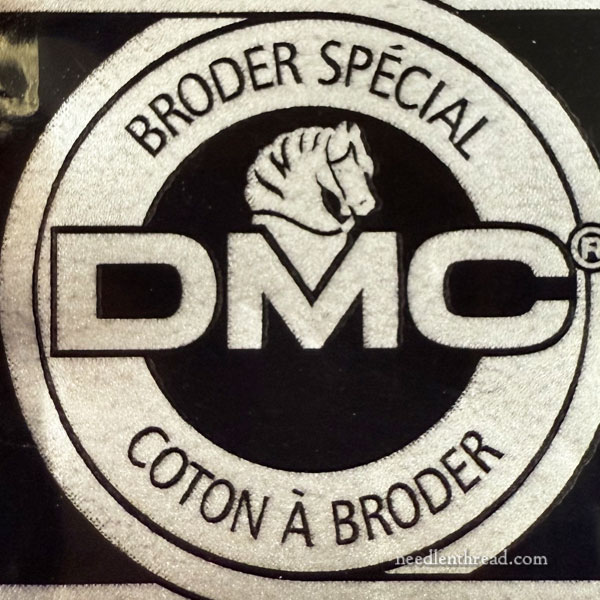
Coton a broder labels are silver and black.
Notice that the thread is called “Broder Spécial,” which is essentially “special embroidery thread.” “Coton a broder” is “embroidery cotton.” So this is a special embroidery cotton.
There is no size indication on this label.
We have to go to the long label on the skein to find that information:
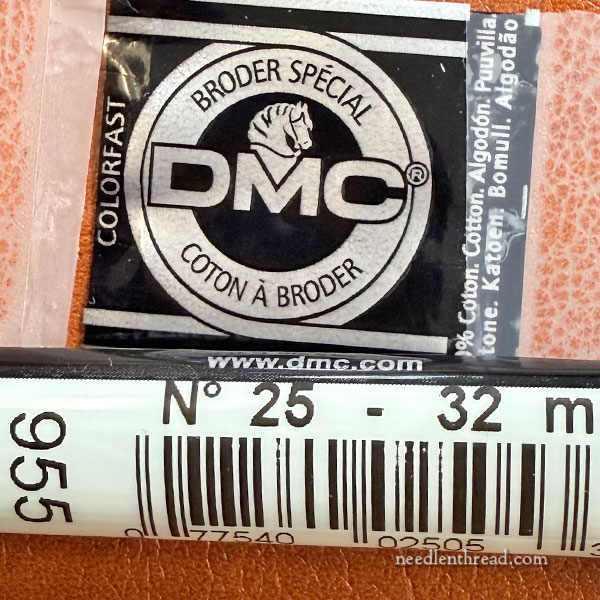
On the long UPC label on coton a broder, you will find three points of pertinent information: the size (#25), the length (32 meters), and the color number, 955 over there on the left.
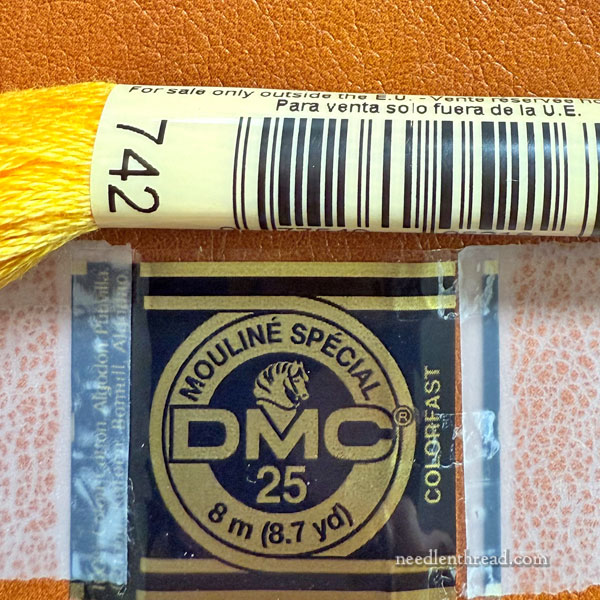
On the longer UPC label on a regular skein of stranded cotton, the only relevant information for most people is that color number on the left – in this case, 742.
So that’s how you can tell these threads apart from their labels.
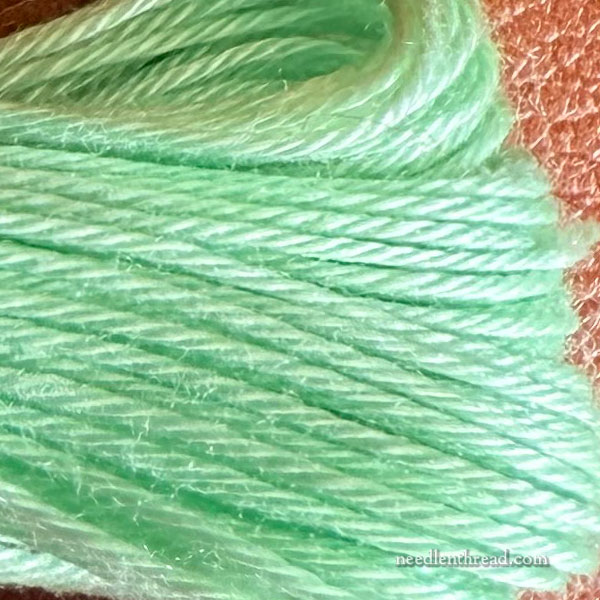
The threads, of course, look different. This is a skein of coton a broder up close. Notice that the thread has a twist, and that it does not have separate strands that can be removed from it.
It is one strand. When you pull it off the skein to use it, you pull off just that one strand, cut it, and use it in the needle.
The recommended needle size (according to DMC) is a #6 crewel (also called “embroidery”) needle. I typically use a #7, and I’ve even used a #8. Use the needle you’re most comfortable with, that works well with the fabric you’re using.
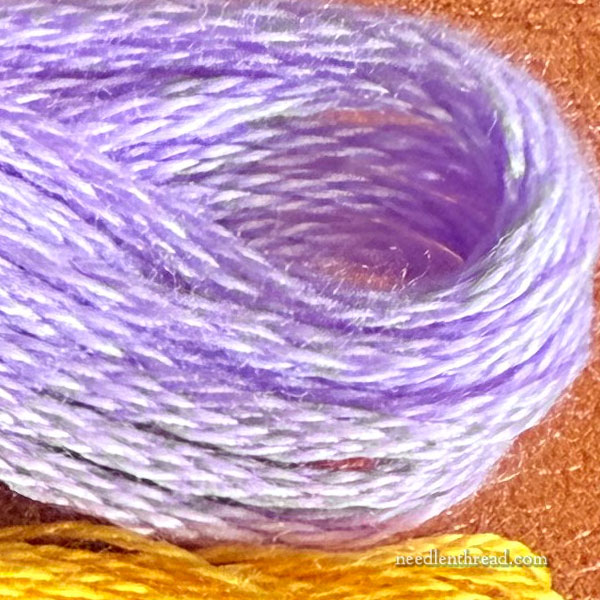
Cotton floss (stranded cotton) looks decidedly different. You can see the separate strands in the bunch. You cut the length of thread you want to use from the skein, separate out the individual number of strands you want to stitch with (one strand at a time – called “stripping” your floss), put those strands back together and then thread your needle with them.
The size needle you use depends on the number of strands you’re stitching with (as well as the type of fabric you’re using, and what is most comfortable for you).
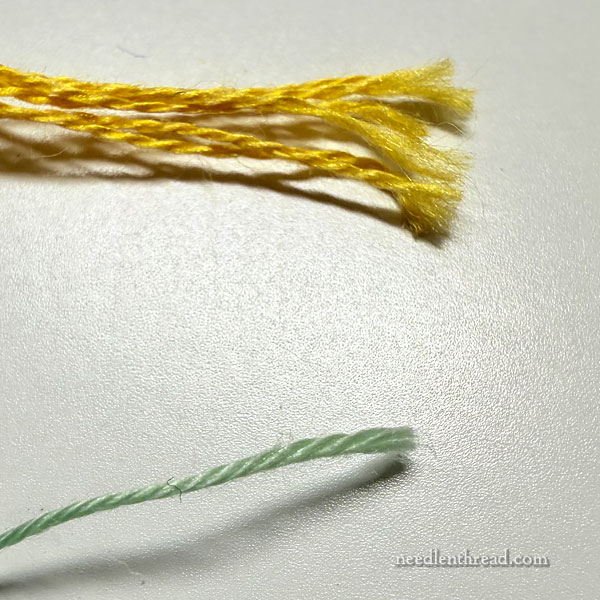
Here’s a close-up on the cut strand of floss at the top of the photo, and the single cut strand of coton a broder at the bottom of the photo.
One strand of coton a broder #25, weight-wise, is about 1.5-2 strands of floss. In other words, two strands of floss stitched is slightly “heavier” than coton a broder #25 stitched.
Want More Information?
Gosh, there’s a whole lot of information about these threads and their differences here on Needle ‘n Thread. Here are some links to some other articles that you may find helpful, if you’re eager to learn about these threads:
A Brief Guide to Cotton Embroidery Threads – an overview of the various available cotton embroidery threads
Detailed information about coton a broder
Coton a Broder for Whitework Embroidery
Sizing Up Cotton Threads – comparison in thread sizes between perle, floss, floche, and coton a broder
Comparing Cotton Embroidery Threads, Stitched
What’s New?
Just a quick note to let you know that some things seem to be shifting in my work routine. My dad is requiring more care at home especially in the mornings, which throws off my writing groove.
It’ll probably take a little while for me to settle into a workable routine to accommodate these changes at home, so you might continue to see a little glitching in the regular Needle ‘n Thread schedule now and then. Everything will iron out into a new, workable routine eventually, I’m sure. Just a little patience, and it’ll all work out! Thanks!


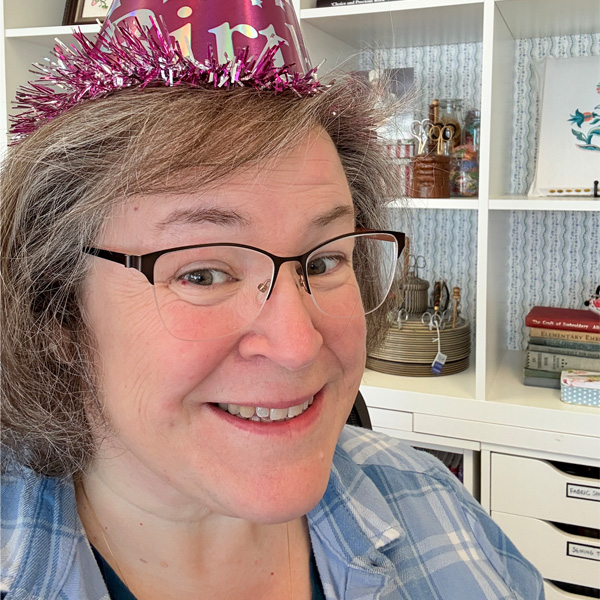
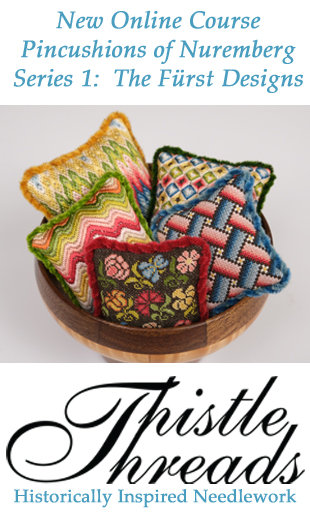
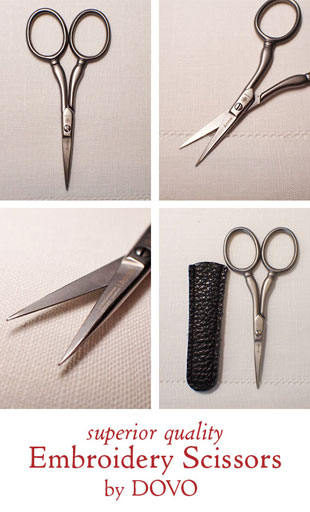
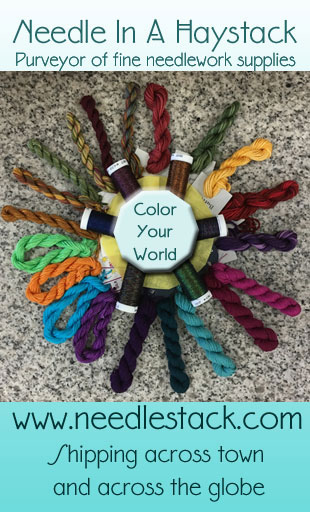
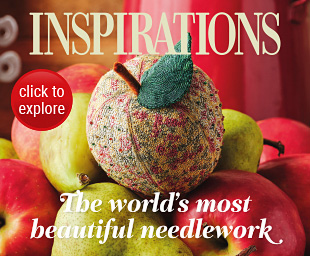
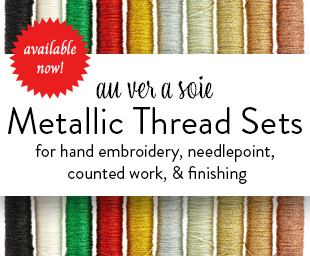
Where can you buy Coton a Broder? The DMC site in English has the thread but you can’t buy it.
Needle in a Haystack carries it. Lacis carries it. I’ll also be carrying it soon!
I’m so glad you can help out your dad. That’s great to be nearby. Thanks for the info on the coton a broder.
He lives with me. I take care of him 24/7! 🙂
Hello Mary, we all appreciate your posts so much – detailed explanations of vital information for us as stitchers. Take time for your family, and for yourself, and take care to sit in the sun and smell the roses (and do a little stitching or reading just for you). Thank you so much
I was so excited to get this book, but after trying to find the correct thread which the helpful lady at Needle in the Haystack said is only brought into this country in black, white, and ecru so I bought hanks floche in no.16. Which works okay, I guess. I hate to say that the directions given in The ABC of Padded Stitch leaves much to be desired. I can’t make out what I am supposed to be doing, how many threads, etc. Even using Susan O’Connor’s Monograms in addition I am still having trouble getting through the process of creating the letters. This book isn’t great for beginners which I am one but I have always wanted to do this type of work. Any suggestions as to where to get the correct thread would be appreciated. And if you could share some tips on how to make the letters would be really appreciated!
Try Lacis.com for the coton a broder in all colors. It is available in the US in the colors. I’m planning on making it available at Needle ‘n Thread a little later this year, too.
Also, just so you know, it is every only ONE strand of coton a broder, as it comes off the skein. In the book, Elisabetta only uses coton a broder #25 in white, blue, or red.
You can also find lots articles here on Needle’n Thread about padded satin stitch, and about monogramming. These two articles might help:
Part I: https://www.needlenthread.com/2008/06/hand-embroidered-monogram.html
Part II: https://www.needlenthread.com/2008/06/hand-embroidered-monogram-on-linen-2.html
If you use the search feature and search “padded satin stitch” here on the website, you’ll come up with other information that you may find helpful, too.
Mary, what a great way to honor your dad by caring for him. We had my father in our home for about a year. Take good care of yourself too. <3 🙂 Laura
I noticed with great interest that the label on your photo of the stranded cotton colour 742 states that it is for sale only OUTSIDE the E.U. I wonder why DMC makes different threads for export as opposed to selling the same threads worldwide.
They don’t make different threads – they make different labels, to differentiate threads sold from the US vs threads sold within the EU, for the sake of import / export excises, duties, and so forth. In the EU, in fact, the thread is more expensive. But it’s all the same thread.
Thank you for this Thread Lesson. I grew up with DMC 6-strand and thought it was the only thread in the world for hand embroidery. Now I am diving into different kinds of embroidery and discovering the world of threads. My fingers itch to try the coton a broder.
You and your Dad. Bless you both.
Coton a broder looks “woolier” or more matt then cotton floss, is that true?
Also, I am working on a self designed project and doing the short and long stitch in floss for the first time in decades. However, instead I’m doing an uneven running split stitch which I do with the runs next to each other. Seems to me to be awfully similar to the short and long. Is this good or bad? PS, prayers for your father…
Hi, Ellen, that’s essentially what long and short stitch is, when you’re working in longer lines or on more linear designs. But really, it is just split stitch, worked to fill. It can be very rigidly worked in rows, or you can can be much more relaxed about it.
Coton a broder is a mercerized cotton, so it does have a sheen. Still, it’s a softer cotton, which is why you see that “wooly” look in the close-up shots.
Hello Mary,
I just purchased the three collections that you have available of DMC Floche. Will you be restocking the remaining six collections (Heritage Cool, Sea & Sand, Forest Floor, Rose Garden, Autumn Glow, and Spring Frost)? I hope so. It is an advantage to be able to purchase a lesser amount of floche than what is on a normal retail skein.
Thank you,
Audrey
Hi, Audrey! Yes, we will. We’ll be doing that this summer – we’re planning on working on it in June. If you want to drop a line and ask for an email when they’re back in stock, that would be great. It needs to come through email, so that we can add you to our advanced notice email list. Thanks!